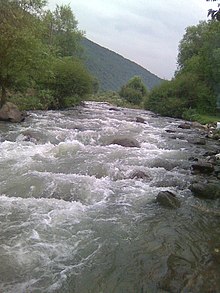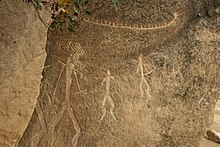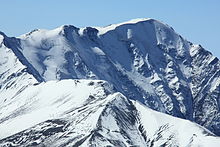Tourism in Azerbaijan
The tourism in Azerbaijan is one of the most important sectors of the economy . Azerbaijan as a holiday destination has favorable conditions for tourism: high mountains and low mountain ranges, lake and river landscapes, the coasts of the Caspian Sea , untouched nature, mineral springs, numerous cultural monuments and a multitude of cities steeped in history.
Azerbaijan borders on five states: in the north on Russia , northwest on Georgia , in the south on Iran , in the west on Armenia and - via the Autonomous Republic of Nakhichevan - on Turkey . Azerbaijan is home to nine of the world's eleven climate zones.
Economical meaning
According to the Azerbaijani Ministry of Culture and Tourism, the country was mainly visited by Russians (32%), Georgians (20%), Iranians (13%) and Turks (11%) in 2017. In 2017, about 2.7 million tourists visited Azerbaijan. According to official information, the number of foreign tourists increased by 20% in 2017 compared to 2016.
According to the State Statistical Committee of Azerbaijan in 2017, there are a total of 540 hotels and hostels in Azerbaijan. Azerbaijan has hotels and commercial apartments with 38,226 beds (2016).
Cities
Baku
The historic old town of Baku (İçəri Şəhər) has been a UNESCO World Heritage Site since 2000 .
Ganja
Ganja is known for the house made of bottles, built in 1967 by the architect Ibrahim Jafarov.
Qobustan
Qobustan National Park is known for its Stone Age rock carvings, which are up to 40,000 years old. The heritage site covers an area of 537 hectares. Another attraction in the area are the mud volcanoes . According to data, 30% of all mud volcanoes in the world are in Azerbaijan.
Qobustan is about 60 kilometers away from Baku.
Naftalan (bathing in petroleum)
In Naftalan, a bath in petroleum is offered as a special spa therapy. A special non-flammable petroleum is considered a remedy, named Naftalan after its town of origin . The petroleum is said to alleviate skin diseases as well as to be good against 70 ailments, including psoriasis, arthritis, nervous disorders, back problems. In the travel report from the 13th century, Marco Polo describes oil from Naftalan as a "spring from which oil leaps in abundance - not edible, but suitable for burning and for treating people and animals with scabies and camels with hives and ulcers".
Winter tourism
Rockclimbing
Apart from the coastal region in the east, Azerbaijan is mainly surrounded by mountains. In the north there is the eastern part of the Greater Caucasus, in the west the Lesser Caucasus and in the south, on the border with Iran, the Talysh Mountains. In Azerbaijan, the mountains are considered a place of hunting, recreation and mountaineering.
The highest mountain, Bazardüzü with 4466 meters, is located directly on the border with Dagestan .
Tufandag ski resort
Tufandag Ski Resort is located in the north-west of Azerbaijan, four kilometers from Gabala . Ten ski slopes up to 15 km in length and with different degrees of difficulty are available to tourists and winter sports enthusiasts. There are also four cable cars in operation.
Shahdag ski resort
Shahdag Mountain Resort is the first and largest winter sports resort in Azerbaijan. The ski area is located in the northeast of the country and was opened in 2011. There are 17 km of slopes available for skiing and snowboarding. The winter sports area is at an altitude of 1,435 to 2,100 meters.
Summer tourism
Azerbaijan has 150 kilometers of pure sandy beaches on the Caspian Sea. The climate on the west coast is assigned to the Mediterranean type. The waters of the Caspian Sea are rich in mineral salts.
Picture gallery
Individual evidence
- ↑ Tourism statistics | Ministry of Culture and Tourism of the Republic of Azerbaijan . In: Mədəniyyət və Turizm Nazirliyi . ( gov.az [accessed February 13, 2018]).
- ↑ a b Azerbaijani tourism grew by 20 percent in 2017 . ( azertag.az [accessed February 12, 2018]).
- ↑ a b STATE STATISTICAL COMMITTEE OF THE REPUBLIC OF AZERBAIJAN, AZERBAIJAN - FACTS AND FIGURES, p. 12. ( Memento of the original dated August 7, 2017 in the Internet Archive ) Info: The archive link was inserted automatically and has not yet been checked. Please check the original and archive link according to the instructions and then remove this notice. Retrieved on February 16, 2018 (PDF; German)
- ↑ Tuncay Huseynzade: Cultural Cooperation. Retrieved February 16, 2018 .
- ^ House made of bottles in Gəncə - Tourism - 2000 . In: Tourism - 2000 . October 17, 2017 ( tourismus-2000.de [accessed February 19, 2018]). House made of bottles in Gəncə - Tourism - 2000 ( Memento of the original from February 19, 2018 in the Internet Archive ) Info: The archive link has been inserted automatically and has not yet been checked. Please check the original and archive link according to the instructions and then remove this notice.
- ↑ UNESCO World Heritage Center: Gobustan Rock Art Cultural Landscape. Accessed February 13, 2018 .
- ↑ Mud volcanoes in Azerbaijan | Florian Neukirchen. Retrieved on February 13, 2018 (German).
- ^ Stefan Weißenborn: In Azerbaijan, spa freaks bathe in petroleum . In: THE WORLD . November 29, 2017 ( welt.de [accessed February 12, 2018]).
- ↑ a b Translation: Wieland Freund: Other countries, other customs . In: THE WORLD . December 27, 2009 ( welt.de [accessed February 12, 2018]).
- ↑ Tufandag Mountain Resort: SKI AREA - Tufandag Mountain Resort. Accessed February 13, 2018 .
- ↑ Shahdag Mountain Resort. Accessed February 13, 2018 .
- ↑ Slopes map In: shahdag.az , accessed on 28 March 2018th
- ↑ Tourism. In: stuttgart-aserbaidschan.de. Retrieved February 15, 2018 .













